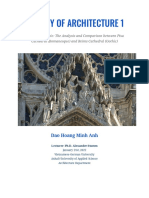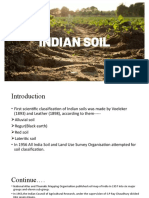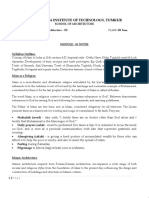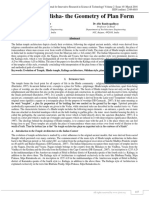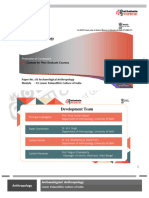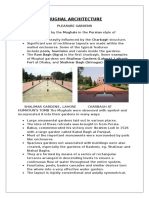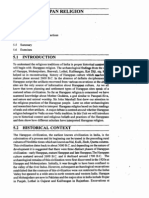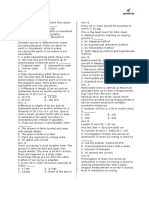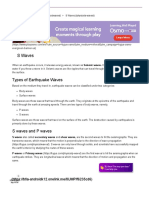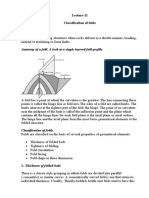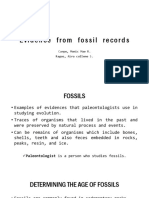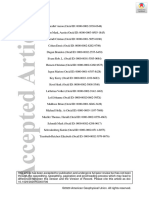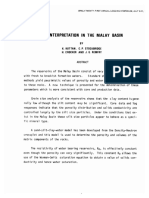100%(1)100% found this document useful (1 vote)
306 views8 pagesBordes, 1961
Uploaded by
João SamuelCopyright
© © All Rights Reserved
We take content rights seriously. If you suspect this is your content, claim it here.
Available Formats
Download as PDF, TXT or read online on Scribd
100%(1)100% found this document useful (1 vote)
306 views8 pagesBordes, 1961
Uploaded by
João SamuelCopyright
© © All Rights Reserved
We take content rights seriously. If you suspect this is your content, claim it here.
Available Formats
Download as PDF, TXT or read online on Scribd
You are on page 1/ 8
22 September 1961, Volume 134, Number 3482 SOlENCE
CURRENT PROBLEMS IN RESEARCH agree that there were four: Wiirm I,
II, III, and IV. However, in central
Europe only three are usually recog-
nized. Hence, WiUrm I and II of the
Mousterian Cultures in France French classification correspond to
Wurm I of the German classification.
We need not bother about who is right,
Artifacts from recent excavation dispel some for the question has little bearing on the
popular misconceptions about Neanderthal man subject of this discussion.
Frangois Border Sites and Climate
As a general rule, Mousterian peoples
in France lived in two different environ-
ments-caves and rock shelters in the
One of the stages in the history of logical, chronological, and ecological valleys of southern and eastern France
mankind in which there has been most setting of Mousterian man. The Pleisto- and open-air sites on the great loessic
popular interest is that linked with cene period witnessed, four times at plains of the northwest and the plateaus
Neanderthal man. The imagination is least, the advance of huge sheets of ice of the south. This led to differences in
caught by this being, close enough to in northern Europe and in the moun- their ways of life and had certain in-
Homo sapiens to be called a man, but tains of central Europe. These glacia- fluences on assemblages of tools. Ex-
distant enough, in shape as well as in tions are known in Europe under the cept, possibly, during an interstadial,
time, to appear in a way an "alien" names of Giinz, Mindel, Riss, and Mousterian men lived under cold cli-
in the sense in which the word is used Wurm (from the oldest to the latest). matic conditions. The climate at the
by science fiction writers. Hence, many The exact correspondence with the beginning of the Last Glacial was prob-
misconceptions are to be found in North American glaciations is yet to be ably more damp than truly cold, but in
popular books, even textbooks, the most worked out. Within each of these glacia- due course the average yearly tempera-
common being the one about the tions were periods of less severe climate, ture fell far lower than that of today in
"brutish Neanderthals." Reconstruc- the interstadials. Between the glacia- the same areas. (However, we must not
tions show him as only a little better tions were long periods of fairly warm make the mistake of imagining the
off than the big apes, and his tools conditions, the interglacials. There are Mousterian environment to have been
(Mousterian) are described as "crude" no special names for these European the barren ground or even the tundra of
by people who would not, to save their interglacials, as there are for inter- present-day northern countries. The
lives, be able to make them. The truth glacials in the United States; we identify latitude was the same as today, and the
is, indeed, quite different. them in terms of the glacial period summers must have been fairly long
In the long story of man's evolution, which preceded and of that which fol- and warm.) As a consequence of the
the people of the Mousterian are very lowed them. severe cold the limestone of the shel-
near us. If we suppose that the first to The roots of some Mousterian cul- ters flaked off; the cultural remains
make tools, thus bridging the gap be- tures can be found during the Riss were, accordingly, covered with con-
tween apes and man, were the Austra- glaciation in the Clactonian complex, gelifracts when the shelter was deserted
lopithecinae, we must put them very an assemblage of cultures without hand by man, so the different layers are
early-about 600,000 years ago. On the axes. The roots of others are found in separated and give a good basis for the
other hand, the last of the Mousterian the Acheulean complex. During the Last determination of stratigraphy.
peoples lived about 35 to 40 thousand Interglacial (Riss/Wiirm) there are The fauna was a "cold" fauna-
years ago (in France) and probably already some assemblages which can be reindeer, arctic fox, and arctic hare-
much later in Africa. Their culture is called Mousterian, but it is in the Last but there was a great abundance of big
also much closer to that of the first Glacial period, the Wurm, that the true game: bison, wild oxen, horses, several
Upper Paleolithic men than is generally Mousterian evolved. This Last Glacial kinds of deer, mammoth, rhinoceros,
believed, and the "gap" between Middle period is divided into substages, the and so on. The carnivores included
and Upper Paleolithic does not exist. It number of which is given variously by bears, lions, panthers, hyenas, and
was merely the result of insufficient different authors. Some authors give wolves.
data. two subdivisions, others three, but now,
The author is professor of prehistory at the
First, let us have a look at the geo- in France, most Pleistocene geologists University of Bordeaux, Bordeaux, France.
22 SEPTEMBER 1961 803
Typological Subdivisions France), he found several layers of (type A) in which there are numerous
Mousterian of Acheulean tradition be- hand axes (from 8 to 40 percent of the
For a long time it was thought that tween two layers of Typical Mousterian. artifacts), among which are triangular
the Mousterian was a single culture The picture has been further compli- forms (Fig. 1, No. 14), together with
which evolved in the following fashion. cated as a result of my own studies of heart-shaped axes (cordiforms) (No.
First, logically following the Acheulean, Mousterian assemblages, made by statis- 12). These are associated with fairly
came the Mousterian of Acheulean tical methods. It is now known that the numerous side scrapers (from 20 to
tradition, with many hand axes. Then term Mousterian encompasses a com- 40 percent) (No. 2), denticulate tools
came the Typical Mousterian, without plex of cultural groups, some closely (about 10 to 15 percent) (No. 7), some
hand axes. Then came the Evolved related, others not so closely related points (No. 1), and knives made on a
Mousterian, without hand axes and with or even of different origin. The follow- flake on which one of the edges has
special types of scrapers (as in La ing different groups are recognized. been blunted by abrupt retouch (No. 5).
Quina, Charente, southwestern France). 1) Mousterian of Acheulean tradi- The side scrapers, generally flat, are of
Doubt was first cast on the validity of tion. Contrary to what is often stated, several types. The backed knives, to-
this straightforward scheme by the great this is not always an "old" Mousterian, gether with the hand axes, are typical
French prehistorian Denis Peyrony. In and it can be found in Wiurm II as well of this Mousterian of Acheulean tradi-
the lower shelter at the classic site of as in Wurm I. But an evolution is tion. There are also other tools, some of
Le Moustier (Dordogne, southwestern clearly to be seen. First there is a phase Upper Paleolithic type, such as end
scrapers (Nos. 3 and 9), gravers (No.
8), borers (Nos. 10 and 11), and trun-
cated flakes or blades (No. 6).
After the Wurm I/Wurm II inter-
stadial, this Mousterian of Acheulean
tradition passes into an evolved phase
(type B). The hand axes are far less
numerous than in the type A phase
(seldom more than 4 or 5 percent), and
none is triangular. There is a cor-
responding drop in the number of side
scrapers (down to 4 to 10 percent). The
number of knives increases (sometimes
up to 20 percent), and these are more
elongated, being made on blades as well
as on flakes (Fig. 1, No. 4) and sug-
gesting the Chatelperron knife of the
early Upper Paleolithic (Perigordian I).
There is a similar increase in the num-
ber of denticulate tools (up to 25 per-
cent and more). The flaking technique
is more laminar, and even little blades
appear, as is shown by the appearance
of bladelet cores (No. 13).
It is in fact very difficult to distin-
guish between a very late Mousterian of
Acheulean tradition and an early Peri-
gordian I. From the point of view of
tools in the assemblage there is really
no distinction between the two.
At the beginning, Perigordian I has
a basic tool kit of Mousterian tools,
with, however, more blades, more bu-
rins and end scrapers, and a special type
of backed knife, the Chatelperron knife,
which, even if foreshadowed by the
Mousterian backed knives, is generally
more elongated. Mousterian types of
backed knives do survive. Very quick-
ly, this Perigordian I evolves toward
the Upper Perigordian (or Gravettian),
losing the Mousterian types of tools,
developing end scrapers and many types
Fig. 1. Mousterian of Acheulean tradition: 1, point; 2, side scraper; 3, end scraper; of burins; the back of the knives, in-
5, backed knife; 7, denticulate tool; 10, 11, borers; 12, cordiform hand axe; 14, tri-
angular hand axe. Evolved Mousterian of Acheulean tradition: 4, backed knife; 6, stead of being curved as in the Mous-
truncated flake; 8, double burin; 9, end scraper; 13, bladelet core. terian or the Chatelperron types, tend
804 SCIENCE, VOL. 134
to be straight. At the same time, bone one side the flaking is very shallow and Levallois Technique
tools are more numerous and better flat, on the other there is scalar retouch.
made. One edge is often left unworked, or is Such are the four main typological
2) Typical Mousterian (Fig. 2, Nos. more crudely worked than the other, subdivisions of the Mousterian. Cutting
1-7). The Typical Mousterian at first but sometimes the two edges are re- across this typological division is a tech-
seems very much like the Mousterian touched equally well, and then it is nical divisi-on. There was, in the Middle
of Acheulean tradition (type A). There easy to mistake these tools for hand Paleolithic, a special method of pro-
are side scrapers (rather flat) (25 to axes. There are also some denticulates, ducing flakes, called the Levallois tech-
55 percent), some denticulates and some notched tools, and some burins, nique after a suburb of Paris where this
notched tools, and well-made points. borers, and end scrapers; these latter special type of flaking was first found,
But there are few or no hand axes or may be either of the carinate or of the in the last century. To make a Levallois
backed knives (0.5 percent at most). nosed types (Fig. 3, No. 7). Another flake you take a flint nodule (Fig. 4,
Some thick side scrapers of La Quina tool found in relative abundance is the No. 1) and flake it off all around the
type (see below) are to be found (as in "limace" (shaped like a slug) (No. 4). margins (No. 2). Then, using each of
the Mousterian of Acheulean tradition), This is not unknown, however, in the these flake scars in turn as a striking
but these are so few (at most, 1 per- Typical Mousterian. platform, you flake away the upper sur-
cent) as probably not to be truly signifi- The relative proportions of Quina- face of the nodule (No. 3). Then you
cant. (When one undertakes to make type scrapers (with respect to scrapers prepare a special striking platform
a side scraper on a thick flake, the in general) in the different Mousterian (either plain or faceted) at one end and
odds are good that he will make a groups are summarized in Table 1. you strike off a large flat flake (No. 5);
Quina-like tool without trying to.)
So, the main difference between
Mousterian of Acheulean tradition
(type A) and Typical Mousterian lies in
the fact that hand axes and knives are
found in the former and not in the
latter. This is a truly significant differ-
ence.
3) Denticulate Mousterian (Fig. 2,
Nos. 8-17). In this group there are no
hand axes (at least typical ones) or
backed knives. There are few or no
points and very few scrapers. If you are 2
willing to call any flake with some I
working on the edge a "scraper," the 3 4
figure may be as high as 13 percent,
but if you insist on a narrow definition
of the scraper, it is very unlikely that -2
the figure will be more than 3 to 7
percent. But there are notched tools
and denticulate tools galore. In some 2~~~~~'
~ ~~ -~\
layers the two types, taken together,
comprise nearly 80 percent of the as- 5 cm 7
semblage; side scrapers, end scrapers, 6
burins, borers, and so on constitute the
remainder.
4) Quina-type Mousterian (Fig. 3).
Here the picture is definitely different.
Very few or no hand axes and backed
knives are found, but there are many
more side scrapers (up to 75 percent 9
or more), often magnificent ones. And I 1J2
among them, side by side with the
ordinary types, are special ones-scrap-
ers of the Quina type. These are made
on thick flakes, usually have a convex
working edge, and have a special type
of retouch, like the overlapping scales
of a fish (Fig. 3, No. 1). Such scrapers
may be either side scrapers or scrapers 13 `,/ 14 I s -w-A 16 17
of the transverse variety, with the edge
opposite the butt of the flake (No. 8). Fig. 2. Typical Mousterian: 1, point; 2, double side scraper; 3, side scraper; 4, Leval-
lois flake; 5, end scraper on a flake; 6, point; 7, transverse scraper. Denticulate Mous-
There are also bifacial scrapers (No. 3), terian: 8, side scraper; 9, 10, denticulate tools; 11-13, notches; 14, borer; 15, notch;
not to be mistaken for hand axes. On 16, 17, denticulate tools.
22 SEPTEMBER 1961 805
some prehistorians. Actually, such
findings represent only a facies of vari-
ous Mousterian groups, found in places
where flint was plentiful and readily
available-mainly in open-air sites
where a nomadic way of life prevailed.
The question arises, of course,
whether the different types of Mouster-
ian represent distinctive cultures, or
whether, like the Levalloisian, they are
2 merely facies of the same culture. They
might be the result of cultural evolu-
tion or only of seasonal variations. This
question probably can be clearly an-
swered in the present stage of our
knowledge.
Hypothesis of Seasonal Variation
The hypothesis of seasonal variation
seems unacceptable for several reasons.
It is difficult to accept the idea that the
peoples of the Mousterian changed their
tool assemblage four times a year,
according to season. Moreover, the
thickness of occupation layers in the
caves and shelters argues against a
one-season stay. Each layer indicates a
stay of considerable length. One might
suppose that there were spring, summer,
autumn, and winter caves, occupied
only at a particular time of year, but it
is difficult to imagine the existence of
a kind of convention among all the
Mousterian tribes, governing the use of
a cave, assuring that a given cave would
be kept as a "spring cave" and that no
summer or winter cultural material
would be mixed with the spring tools.
Fig. 3. Quina-type Mousterian: 1, side scraper, Quina-type; 2, end scraper; 3, bifacial Moreover, we have very good reason to
scraper; 4, "limace"; 5, side scraper; 6, transverse scraper, Quina type; 7, nosed end think that these caves were occupied all
scraper (Aurignacian type); 8, transverse scraper, Quina type; 9, retouched blade
(Aurignacian type). year round. It is possible to tell, from a
study of a reindeer's antlers and teeth,
how old the animal was when it was
the shape of the flake is predetermined Mousterian that show use of the Leval- killed, and as a consequence, since the
by the previous shaping of the core lois technique are known as Ferrassie- typical birth season of the reindeer is
(No. 6). type Mousterian (from La Ferrassie, known, we can tell at what time of
This technique, developed, in Europe, Dordogne). The use of the Levallois year a reindeer was killed. It appears
by the peoples of the Middle Acheulean, technique has the effect of lowering that reindeer were killed at all times
was used until the end of the Mous- the percentage of Quina-type scrapers, of the year by the occupants of these
terian and even later. It was not used since Levallois flakes are flat, and caves-proof that man occupied the
by every Mousterian tribe, however. Quina-type scrapers can only be made caves all year round.
For instance, there is a Mousterian of on thick flakes (Table 1). Also, in the
Acheulean tradition with Levallois flak- Ferrassie-type Mousterian there are
ing (as in Le Moustier) and there is fewer transverse scrapers than in the Hypothesis of Cultural Evolution
another with little such flaking (as in Quina-type Mousterian, for Levallois
the Pech de l'Aze cave, Dordogne). The flakes, being rather elongate, are not As I said earlier, doubt was cast long
same is true for the Typical Mousterian suitable for use as transverse scrapers. ago on the validity of the hypothesis of
and for the Denticulate Mousterian. But The existence of a special "culture," cultural evolution when Peyrony exca-
in the case of the Quina-type Mous- the Levalloisian, characterized by the vated the lower shelter at Le Moustier
terian, things are a little more com- existence of numerous unretouched and found three layers of Mousterian
plicated. Assemblages of the Quina-type Levallois flakes, has been proposed by of Acheulean tradition between two
806 SCIENCE, VOL. 134
layers of Typical Mousterian. Actually, Another hypothesis links these vari- Table 1. Relative proportions of Quina-
type scrapers (with respect to scrapers in
the sequence at Le Moustier is even ations in tool assemblages to the envi- general) in the various cultural groups of
more complex than this (see Fig. 5). ronment. But it is easy to show that the Mousterian.
The sequence is substantiated and the Mousterian people who lived under Cultural group Propor-
evidence is supplemented by findings very different environmental conditions tion (%)
from other caves and shelters-for in- had the same type of tool assemblage; Mousterian of Acheulean tradition O to 0.9
the site of Amn Meterchem, in Tunisia, Denticulate Mousterian O to 0.1
stance, the cave at Combe-Grenal, near Typical Mousterian 0 to 1
Domme (Dordogne), in which I have yields a Mousterian assemblage which Quina-type Mousterian 15 to 25
been making excavations since 1953. is very close to that found at La Fer- Ferrassie-type Mousterian 6 to 9
The cultural sequence in the Combe- rassie. On the other hand, in the same
Grenal cave, from top to bottom, is as geological layer, and thus representative
follows (Fig. 6): (i) Mousterian of of people living under very similar called "Tayacian" assemblage of layer
Acheulean tradition (here in terminal climatic conditions, one sometimes finds 3 (of Riss Glacial age) at La Micoque
position); (ii) several layers of unidenti- two very different cultural horizons, as near Les Eyzies (Dordogne) or in the
fiable Mousterian (A2, A3, B1, B2); (iii) at Pech de l'Aze, cave II (Dordogne). High Lodge type of Clactonian industry
two layers of Typical Mousterian with So, the existence of different cul- in England. The Ferrassie-type Mouster-
Levallois flaking (B3 and B4); (iv) a tures within the Mousterian complex ian might have its roots in layer 4
poor layer (C), which is probably Den- appears to be an established fact. The (Riss Glacial age) of La Micoque, or
ticulate Mousterian; (v) layer D 1, prob- question then arises, What were the in cultures like that found at Ehrings-
ably Denticulate Mousterian with Le- origins of these cultures? dorf (near Weimar, Germany), which
vallois flaking; (vi) layer D2, probably dates from the Last Interglacial.
Typical Mousterian with Levallois But when one comes to consider the
flaking; (vii) two layers (El and E-2) Cultural Origins origin of Denticulate Mousterian or
of Denticulate Mousterian, the first Typical Mousterian one is almost at a
with Levallois flaking, the other with The Mousterian of Acheulean tradi- loss. Of course some cultural horizons
less Levallois flaking; (viii) three layers tion poses no serious problem. It is at La Micoque might be antecedents of
of Denticulate Mousterian (F, G, HI) logically derived from the Upper the former but unhappily these layers
without Levallois flaking; (ix) layer Acheulean. The only question is have been so thoroughly crushed by
H2, also Denticulate Mousterian but whether it passed through an inter- frost heaving (cryoturbation) that it is
with Levallois flaking; (x) layer I, mediate Micoquian stage or whether it difficult to differentiate between true
Quina-type Mousterian; (xi) layer J, evolved directly, the Micoquian being denticulate tools and other artifacts. As
Denticulate Mousterian without Leval- in part contemporaneous with the Old yet the origins of the Denticulate Mous-
lois. flaking; (xii) layers K, L, M, N, Mousterian of Acheulean tradition. The terian are not known but Denticulate
NI, Quina-type Mousterian; (xiii) latter theory would not necessarily ex- Mousterian is present at the very be-
layer P, Ferrassie-type Mousterian; clude the possibility of a Micoquian ginning of the Last Glacial and extends
(xiv) layers Q, R, RI, Typical Mouster- stage as well. The Quina-type Mouster- to the end of the Mousterian.
ian with Levallois flaking; (xv) layers ian has a possible antecedent in the so- The Typical Mousterian is also a
U1, U2, W, X, Y, all Ferrassie-type
Mousterian; (xvi) layer Z, Typical
Mousterian with Levallois flaking; and
(xvii) layer a, Denticulate Mousterian
with Levallois flaking. (It should be
understood that "without Levallois"
flaking does not mean that there are
no Levallois flakes in the assemblage but
means only that there are very few.)
Under layer ca are several other layers
only now being excavated. It is difficult I
as yet to tell what they are, but they
do not seem to be Denticulate Mouster-
ian.
So, at Combe-Grenal we can clearly
see, interstratified, almost all types of
Mousterian. Elsewhere in the Dordogne,
as at Combe-Capelle (lower site),
Quina-type Mousterian lies below Fer-
rassie-type Mousterian, not above it as
at Combe-Grenal. At Combe-Capelle,
too, the Mousterian of Acheulean tradi-
tion is in a terminal position. However,
in the upper shelter at Le Moustier the
Quina-type Mousterian lies above the 4 6
Mousterian of Acheulean tradition. Fig. 4. Steps in the making of a Levallois flake.
22 SEPTEMBER 1961 807
problem. It closely resembles the What happened to these different the "western Neanderthal" variety and
Mousterian of Acheulean tradition Mousterian cultures in WUrm III? hence that these strains were dead ends
(type A) but lacks hand axes and There is little question that the Mous- from the standpoint of evolution.
backed knives. However, since some of terian of Acheulean tradition must have Actually, very little is known about the
the Mousterian of Acheulean tradition is developed into the Perigordian I. This peoples who made the Mousterian hand
fairly poor in hand axes and knives it is poses a nice problem for those anthro- axes. The skull of a young child from
possible that Typical Mousterian does pologists who believe that all the peoples Pech de l'Aze cave (a child so young
derive from it. of the Mousterian in France were of that the skull tells us little) and some
cranial fragments from other sites are
all that we have. However, there is no
other possible origin, culturally speak-
ing, for the early Perigordian, and
physical anthropologists must accept
this fact. The early Perigordian is a
western culture and is unknown outside
of France and Spain (and perhaps Ger-
many). Distribution maps of the early
Perigordian and of the Mousterian of
Acheulean tradition are very similar
T ..-.--'
except for a small zone of the latter in
the Middle East (Palestine).
It was pointed out long ago that
there are resemblances between the
Quina-type Mousterian and another
stage of the early Upper Paleolithic,
_I
the Aurignacian. In fact most of the
tool types characteristic of the Aurig-
nacian are in a way foreshadowed in
the Quina-type Mousterian, just as the
Hou.st. Ach. Trade Perigordian I tools are foreshadowed in
the Mousterian of Acheulean tradition.
Carinate and nosed scrapers (Fig. 3,
Nos. 2 and 7) exist in the Quina-type
Mousterian; actually such tools are
present as early as the "Tayacian" in
the layers at La Micoque. The special
Quina retouch (see Fig. 3 ) is very
Fig. S. Schematic section at Le Moustier (Dordogne), upper and lower shelters,
close to the kind of retouch used by the
showing the interstratification of several types of Mousterian. Aurignacians on the side of their blades,
and some double side scrapers on blade-
like flakes might be regarded as fore-
runners of the more elongate "Aurig-
nacian blade" (Fig. 3, No.9).
But these affinities are less marked
than those between the Mous·terian of
Acheulean tradition and the Lower
perigordian. Distribution for the Aurig-
nacian is much wider than for the
Lower perigordian. The evidence sug-
gests that the peoples of the Aurig-
nacian invaded the West, bringing with
them a well-developed culture. If there
is a bridge between the Quina and
Ferrassie types of Mousterian and the
Aurignacian, it is to be found outside
of France.
There is some slight evidence that
Ferrassie-type Mousterian survived for
a short time into WUrm III in Provence.
No trace has been found in Upper
Paleolithic cultures of derivatives from
Fig. 6. Schematic section at Combe-Grenal (Dordogne), showing the interstratification either Typical Mousterian or Denticu-
of several types of Mousterian. late Mousterian.
808 SCIENCE, VOL. 134
Ways of Life
What do we know about possible dif-
ferences in the ways of life of these
several groups within the Mousterian?
As yet, very little. Until recently, little
attention has been given, in excavating,
to such matters as the horizontal distri-
bution of tool types in a shelter: Modern
excavations, in France and elsewhere,
are not yet numerous enough to give
any clear answers. In any case, to ob-
tain such information is no easy task.
Mousterian layers are usually very rich
and contain a great mixture of broken
bones, tools, chips, and flakes, together
with congelifracts, pebbles, ashes, and
sometimes charcoal. Even the most
careful excavation will not always re-
veal, for instance, whether some beauti-
ful scrapers in a given grid square A 3
Fig. 8. Fragments of manganese dioxide from the Mousterian-of-Acheulean-tradition
are exactly contemporary with a hand level of Pech de l'Aze (Dordogne). (Top row, from left) unworked lump, triangular
axe in grid square ES. In fact, we can pencil, trapezoidal pencil, rounded pencil; (bottom row) scratched lumps.
seldom achieve this degree of certainty.
And to make distribution graphs for that in every Mousterian context min-
layers more than 1 or 2 centimeters eral color (manganese dioxide, red
thick would lead us exactly nowhere. ocher) was used. Some bits have been
In a thick layer, the only appropriate scratched to make colored powder;
parts for such studies are the bottom others are pointed, like pencils (Fig.
and the top; the bottom is better if the 8). However, there is no cave painting
layer overlies another layer that is that can be traced back to the Mous-
compact and sterile. terian. These colors presumably served
However, fireplaces can often be for body painting.
found, and rough distribution maps for Some hunting habits can also be
some tools can be worked out. In Pech deduced from the animal remains in the
de l'Aze (cave I), for instance, we layers. Thus, it seems that peoples of
found that the hand axes and scrapers the Denticulate Mousterian favored
were more numerous right around the horses as game. Layers from this cul-
fireplaces. There seems to have been a ture are everywhere rich in horse bones.
special place outside for the making of At Pech de l'Aze (cave II), in the same
hand axes, for most of the finds there geological layer and very close together,
'are of flakes such as would be struck there are two cultural levels; one is
off in that process. In the same site, the Denticulate Mousterian and the other
lower (and richest) layer ended against is Typical Mousterian. There is no in-
a low stone wall, just a little outside dication of a long lapse of time or of
the cave and the adjacent shelter. any significant climatic change between
At Combe-Grenal we found a post- the two. However, the animal remains
hole in layer G, extending down to from the former are mainly horse, while
layer K. A cast made of this hole shows those from the latter are red deer and
quite clearly that the post must have wild oxen.
been a pointed wooden shaft driven
into the ground, and that the tip mush-
roomed against a stone in layer K Conclusions
(Fig. 7). This shaft was perhaps one of
a row of shafts used to support skins or All this gives a picture of life in
woven branches to close the cave. Mousterian times that is rather differ-
For half a century it has been known ent from the picture, too often given, of
that the Mousterian peoples buried at brutish half-men, crouching in caves,
least some of their dead. Most of these terrified and not very clever. It seems
burials seem to be associated with the that Mousterian tribes may, at times,
Fig. 7. Cast of a posthole at Combe- Quina-type and Ferrassie-type Mous- have numbered some 30 to 50 individ-
Grenal, layer G (length of the cast, 21 terian cultures; however, some are from uals. These people had weapons to com-
centimeters). the Typical Mousterian. We also know bat cave lions and cave bears, whose
22 SEPTEMBER 1961 809
remains are sometimes found in the these tools already existed in the To conclude, it does not seem that,
occupation layers. They used paints, Acheulean, they were further developed culturally at least, there is any great
were clever flint workers, and buried and diversified in the Mousterian. Even gap between the Mousterian cultures
their dead. It is obvious that they did the multiple tool is found in the and the early Upper Paleolithic cultures
not lack inventive powers. Mousterian (Fig. 1, No. 8); some com- that followed. One of the latter, at least,
Most of the stone tools which were plex tools-for instance, a burin com- has its roots quite -clearly in the Mous-
developed in Upper Paleolithic times bined with an end scraper-are also terian of Acheulean tradition. And even
by Homo sapiens were invented by found, but rarely. if some anthropologists deny to Ne-
Mousterian or even by Acheulean The peoples of the Mousterian also anderthal man (sensu stricto) the right
peoples. The blade (that is, a blade experimented with bone tools, but there to be counted among our direct ances-
made through a special technique of they fall very short of the achievements tors, one thing is sure: these ancestors
debitage and not the result of a flaking of men in the Upper Paleolithic. They of ours were at a cultural level very
accident) goes back at least to the end never did more than make some bone like that of the Mousterian peoples. So
of the Acheulean, and in some Mous- spear points, and in the main they used we come uncomfortably close to the
terian assemblages blades comprise up only bone splinters, shaping them old joke: It was not William Shake-
to 40 percent of the debitage. End crudely. But in this respect the first speare who wrote Hamlet but another
scrapers and burins were known in the people of the Upper Paleolithic (Peri- man who lived at the same time and
Middle Acheulean. The backed knife is gordian I) appear not to have done whose name was also William Shake-
an Acheulean invention also. But if all much better. speare!
CURRENT PROBLEMS IN RESEARCH Our Own Galaxy
Advent of the parameter of chem-
ical composition. It became' possible
to derive an age for a cluster of stars
by observing in the color-magnitude
diagram the absolute magnitude at
Stellar Content of Galaxies which the main sequence broke away
to evolve more rapidly (1). Systematic
observations of clusters of stars led
Two parameters which describe the stars that make up finally to the discovery of a globular
any galaxy are age and chemical composition. cluster, M 3 (2), and a galactic clus-
ter, M 67 (3), in which the observed
main sequences both terminated at the
Halton Arp same absolute magnitude. Presumablv
they were of the same age, but, by
definition, they belonged to different
populations. The contradiction would
only be resolved by attributing the
In order to understand how a spiral arms, in galactic clusters, and conspicuous differences between their
galaxy is formed, how it evolves, and in the neighborhood of the sun. It was color-magnitude diagrams to differ-
how different kinds of galaxies are quickly realized that population I ences in the chemical composition of
related to each other, it is necessary contains the highly luminous, and the stars in the two clusters. That such
to understand the kind of stars a therefore young, stars, while popula- differences exist was borne out by an
galaxy contains. An important impetus tion II is an old population. examination of the spectra (4). From
to the understanding of the relation In the following years galaxies this point forward astronomers began
of the galaxy to the stars which it were widely analyzed in terms of the to talk less about populations I and
contains came in 1944 when Baade relative number of old and young stars II and more about the twin parameters
originated the concept of population they contained, and the designation of age and chemical composition. It
types. According to his original defini- of population type became common in also became apparent that subdwarfs
tion, a type II population consists of astronomical literature. Inevitably this were associated with the halo regions
stars which have the same Hertzsprung- terminology has been modified and in which the globular clusters resided
Russell diagram as globular cluster extended. The new results, which are (5). It was shown that the subdwarfs,
stars, and population-I stars have a just now becoming available, intro- like the globular-cluster giants, were
color-magnitude diagram like stars in duce new concepts, reflect our in- extremely metal-poor (6). It was
creased knowledge of the kinds of obvious now that not only were
The author is assistant astronomer at Mt. Wil- stars galaxies contain, and begin to the globular-cluster stars metal-poor
son and Palomar observatories, Carnegie Institu-
tion of Washingon, California Institute of Tech- offer us further insight into the rela- throughout but that the main sequence
nology, Pasadena. This article is the Helen B. tionships between different kinds of to which they should be fitted was the
Warner lecture delivered 29 December 1960 at
the New York meeting of the AAAS. galaxies as well. subdwarf main sequence.
810 SCIENCE, VOL. 134
You might also like
- Carle Cave Architecture: Patna University, PatnaNo ratings yetCarle Cave Architecture: Patna University, Patna3 pages
- History of Eastern Architecture: Early Chalukyan (Patadakal Temple)No ratings yetHistory of Eastern Architecture: Early Chalukyan (Patadakal Temple)29 pages
- N. Athiyaman Department of Maritime History and Marine Archaeology, Tamil University Thanjavur 613010, IndiaNo ratings yetN. Athiyaman Department of Maritime History and Marine Archaeology, Tamil University Thanjavur 613010, India15 pages
- Lect. 02.a. Indian and Pakistan ArchitectureNo ratings yetLect. 02.a. Indian and Pakistan Architecture102 pages
- Kausambi by DAYA RAM SAHNI, M.a., R.B. (Archaeological Survey of India) (PLATE V)No ratings yetKausambi by DAYA RAM SAHNI, M.a., R.B. (Archaeological Survey of India) (PLATE V)12 pages
- Temples of Odisha-The Geometry of Plan FormNo ratings yetTemples of Odisha-The Geometry of Plan Form5 pages
- List of World Heritage Sites in India - WikipediaNo ratings yetList of World Heritage Sites in India - Wikipedia44 pages
- Buddhist and Jain Cave Temples and VinarsNo ratings yetBuddhist and Jain Cave Temples and Vinars12 pages
- Pillars of Ashoka - Wikipedia, The Free EncyclopediaNo ratings yetPillars of Ashoka - Wikipedia, The Free Encyclopedia6 pages
- DR Sushma Ahuja Jhalarapatan Sun TempleNo ratings yetDR Sushma Ahuja Jhalarapatan Sun Temple52 pages
- DR Uday Dokras. PHD Stockholm Sweden: Antarala-Intermediate Space in Hindu Temple DesignNo ratings yetDR Uday Dokras. PHD Stockholm Sweden: Antarala-Intermediate Space in Hindu Temple Design10 pages
- Features of Chalukya Sculptures, Indian SculptureNo ratings yetFeatures of Chalukya Sculptures, Indian Sculpture2 pages
- Excavations at The Palaeolithic Site of Attirampakkam, South India: Preliminary FindingsNo ratings yetExcavations at The Palaeolithic Site of Attirampakkam, South India: Preliminary Findings9 pages
- Indian Historical Review 2013 Gurukkal 181 206No ratings yetIndian Historical Review 2013 Gurukkal 181 20626 pages
- Early India and Its Cultural ProductionsNo ratings yetEarly India and Its Cultural Productions131 pages
- History Assignment : The Later Chalukya Phase (Hoysala)No ratings yetHistory Assignment : The Later Chalukya Phase (Hoysala)7 pages
- Binford, L & S, Binford. A Preliminary Analysis of Functional Variability in The Mousterian of Levallois FaciesNo ratings yetBinford, L & S, Binford. A Preliminary Analysis of Functional Variability in The Mousterian of Levallois Facies59 pages
- Binford, Binford - 1966 - A Preliminary Analysis of Functional Variability in The Mousterian of Levallois Facies PDFNo ratings yetBinford, Binford - 1966 - A Preliminary Analysis of Functional Variability in The Mousterian of Levallois Facies PDF58 pages
- Dickinson-1983-Provenance of North American PHNo ratings yetDickinson-1983-Provenance of North American PH15 pages
- Soils of The Avaion Peninsula, Newfoundland - 1983No ratings yetSoils of The Avaion Peninsula, Newfoundland - 1983119 pages
- S Waves - Earthquakes Waves, P Waves, S Waves & Surface WavesNo ratings yetS Waves - Earthquakes Waves, P Waves, S Waves & Surface Waves2 pages
- Evidencefromfossilrecords: Carpo, Monic Mae R. Ragos, Aira Collene SNo ratings yetEvidencefromfossilrecords: Carpo, Monic Mae R. Ragos, Aira Collene S5 pages
- Geological Works of Ocean and Coastal Management: Paula May M. Castronuevo Joshua Christopher Dime Rochelle JabianNo ratings yetGeological Works of Ocean and Coastal Management: Paula May M. Castronuevo Joshua Christopher Dime Rochelle Jabian18 pages
- 2020 - Offshore Freshened Groundwater in Continental MarginsNo ratings yet2020 - Offshore Freshened Groundwater in Continental Margins154 pages
